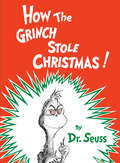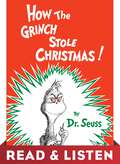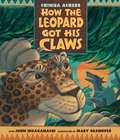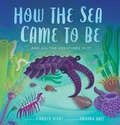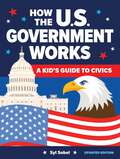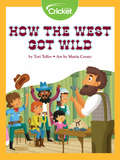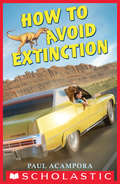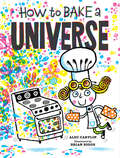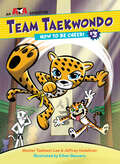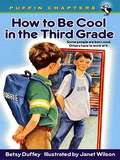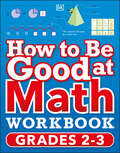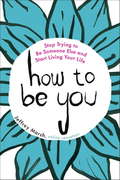- Table View
- List View
How the Grinch Stole Christmas (Classic Seuss)
by Dr. SeussGrow your heart three sizes and get in on all of the Grinch-mas cheer with this Christmas classic--the ultimate Dr. Seuss holiday book that no collection is complete without! Every Who down in Who-ville liked Christmas a lot . . . but the Grinch, who lived just north of Who-ville, did NOT! Not since "'Twas the night before Christmas" has the beginning of a Christmas tale been so instantly recognizable. This heartwarming story about the effects of the Christmas spirit will grow even the coldest and smallest of hearts. Like mistletoe, candy canes, and caroling, the Grinch is a mainstay of the holidays, and his story is the perfect gift for readers young and old. "Irrepressible and irresistible." --Kirkus Reviews
How the Grinch Stole Christmas!
by Dr Seuss<p>“Every Who down in Who-ville liked Christmas a lot . . . but the Grinch, who lived just north of Who-ville, did NOT!” Not since “’Twas the night before Christmas” has the beginning of a Christmas tale been so instantly recognizable. This heartwarming story about the effects of the Christmas spirit will grow even the coldest and smallest of hearts. Like mistletoe, candy canes, and caroling, the Grinch is a mainstay of the holidays, and his story is the perfect gift for young and old. <p>And don't forget to celebrate Grinch-mas this Christmas season, the annual holiday tradition inspired by How the Grinch Stole Christmas that encourages readers to grow their hearts three sizes by doing good deeds!</p>
How the Grinch Stole Christmas! Full Color Edition (Classic Seuss)
by Dr. SeussGrow your heart three sizes—and dazzle your eyes—with this FULL COLOR edition of the beloved holiday classic How the Grinch Stole Christmas!—perfect for Dr. Seuss fans and collectors any time of year!This season of giving, give a gift that's never been given before—a full color edition of How the Grinch Stole Christmas! Originally published in 1957 using just 2 different colored inks (red and black), this edition features Dr. Seuss's original illustrations in full color for the very first time—the way he'd have likely colored them had he published the book today! While this edition is not a replacement for the original, it makes a cheerful addition to the Dr. Seuss canon that is bound to appeal to Dr. Seuss fans of all ages. PS: The drabness of the Grinch's life in his cave compared to the happy, vibrant life of the Whos in Who-ville has never been easier to see!
How the Grinch Stole Christmas! Read & Listen Edition (Classic Seuss)
by Dr. Seuss&“Every Who down in Who-ville liked Christmas a lot . . . but the Grinch, who lived just north of Who-ville, did NOT!&” Not since &“&’Twas the night before Christmas&” has the beginning of a Christmas tale been so instantly recognizable. No holiday season is complete without the Grinch, Max, Cindy-Lou, and all the residents of Who-ville, in this heartwarming story about the effects of the Christmas spirit on even the smallest and coldest of hearts. Like mistletoe, candy canes, and caroling, the Grinch is a mainstay of the holidays, and his story is the perfect gift for young and old. This Read & Listen edition contains audio narration.
How the Leopard got his Claws
by Chinua AchebeIn the beginning, all the animals lived as friends. Their king, the leopard, was strong but gentle and wise. Only Dog had sharp teeth, and only he scoffed at the other animals’ plan to build a common shelter for resting out of the rain. But when Dog is flooded out of his own cave, he attacks the leopard and takes over as king. And it is then, after visiting the blacksmith’s forge and knocking on Thunder’s door, that the angry leopard returns to regain his throne by the menace of his own threatening new claws. In a riveting fable for young readers about the potency and dangers of power taken by force, Nigerian writer Chinua Achebe, author of Things Fall Apart, evokes themes of liberation and justice that echo his seminal novels about post-colonial Africa.
How the Sea Came to Be: (And All the Creatures In It)
by Jennifer BerneA lyrical, spectacular history of the ocean—from its dramatic evolutionary past to its marvelously biodiverse present.&“For millions of years these first bits of lifeBecame more, and then more, and then more.&”Long, long ago, when the Earth was young and new, the world was a fiery place. Volcanoes exploded from deep down below, and steamy, hot clouds rose up high. Rain poured down for thousands of years, filling the world&’s very first oceans. There the teeniest stirrings of life began. Earth&’s creatures grew bigger and bigger, evolving into exciting forms like jellyfish, coral, and worms. Millions of years passed. Down in the depths and up on the surface, ocean life grew and spread. Now the sea teems with all kinds of animals—squid, turtles, dolphins, barracudas, even glowing fish, all living in the waters where long, long ago, life itself came to be. Spanning 4.5 billion years of evolution, this extensively researched book is an accessible introduction to geology, oceanography, and marine biology. Entrancing verse, awe-inspiring art, and fascinating back matter capture the mysterious beauty of the ocean and the incredible organisms who call it home.
How the Sphinx Got to the Museum (How The ... Got To The Museum)
by Jessie HartlandDepicts how the Sphinx was commissioned by the Pharaoh, was built, was rediscovered after centuries and then travelled to New York.
How the U. S. Government Works
by Syl SobelA fine classroom supplement and a solid information source for kids writing social studies reports, this updated, easy-to-read book explains the federal system as it works in the United States today. It also discusses some ways in which the government has changed since the framers of the Constitution brought it into existence in the 18th century. Described are the Legislative body, composed of Senate and House of Representatives, the Executive branch, headed by the President with the Cabinet members, and the Judicial branch, headed by the Supreme Court of the United States, and extending to federal courts throughout the nation. New in this edition are facts about how a bill becomes a law, the various departments in the Executive branch, and more. Young readers learn how officials are elected or appointed and how government agencies work for the people's benefit. A complex process is explained in interesting terms that young readers can comprehend.
How the U.S. Government Works: ...and how it all comes together to make a nation
by Syl Sobel J.D.This updated, easy-to-read book about the United States for kids explains the federal system as it works today. It also discusses why the framers of the Constitution created the U.S. government in the 18th century and the purposes it was designed to serve.Parents, teachers, and gift givers will find:an easy-to-read book about a complex subject revised for the classroom and homecurriculum aligned vocabulary, expanded glossary, discussion questions, and resource guideinformation on how presidents and other officials are elected or appointedDescribed are the Legislative branch, composed of the Senate and the House of Representatives; the Executive branch, headed by the President with the Cabinet members; and the Judicial branch, comprised of the Supreme Court of the United States and the lower federal courts throughout the nation.
How the U.S. Government Works: A Kid's Guide to Civics
by Syl Sobel J.D.Newly updated edition!Discover everything you need to know about American democracy with this easy-to-read guide to our government!How the U.S. Government Works is a fact-packed primer that helps kids understand the many facets of America's federal system. Readers will learn about how the government came to be, the responsibilities of the Executive, Legislative, and Judicial branches, and how our democracy impacts their own lives today!
How the West Got Wild
by Tori TelferChummy and Sandra Bee were the rowdiest little kids in Ruby, Arizona. But when they helped start the gold rush in Ruby, people stopped calling them "wild" and "rambunctious" and started calling them "plucky" and "clever."
How to (Almost) Ruin Your Summer
by Taryn SoudersTop Three Reasons Camp Minnehaha is The Worst1. The spiders (wayyyy too many legs)2. King Arthur (a rampaging goat intent on my destruction)3. Victoria a.k.a The Diva (an evil cabin mate obsessed with French beauty products and my humiliation)Chloe McCorkle knew a summer camp where you had to learn a career was a bad idea. She tried to tell her parents, but they just had to go on vacation to Alaska and ship her off for two weeks. It's not ideal, but she's going to try to make the best of it. She might even learn some skills that will help her make money for the new bike she's been eyeing. But Chloe quickly discovers there's only one area at which she excels; she manages to get more demerits than anyone else in camp...
How to Avoid Extinction (Scholastic Press Novels)
by Paul AcamporaFor fans of Gary Schmidt and Joan Bauer, a laugh-out-loud intergenerational road trip story from acclaimed author Paul Acampora!Since the death of his grandfather, Leo's number one chore has been to chase after his grandmother who seems to wander away from home every few days. Now, Gram's decided to roam farther than ever. And despite his misgivings, Leo's going along for the ride. With his seventeen-year-old cousin, Abbey, and an old, gassy dog named Kermit, Leo joins Gram in a big, old Buick to leave their Pennsylvania home for a cross-country road trip filled with fold-out maps, family secrets, new friends, and dinosaur bones.How to Avoid Extinction is a middle grade comedy about death and food and family and fossils. It's about running away from home and coming back again. For Leo, it's about asking hard questions and hopefully finding some sensible answers. As if good sense has anything to do with it. Against a backdrop of America's stunning size and beauty, it's also about growing up, getting old, dreaming about immortality, and figuring out all the things we can -- and can't -- leave behind.
How to Bake a Universe
by Alec CarvlinThis whimsical and informed debut picture book takes a leaf from a cookbook to show readers how the universe came into being. To bake a universe, you’ll need a heaping pile of nothing. That’s right, not a single thing! Just make sure you have enough . . . Alec Carvlin breaks down the Big Bang into the steps of a recipe, from the formation of quarks and atoms (preheat your oven to Absolute Hot) to the compression of gases into stars and planets (just set your timer for 180 million years). Carvlin expertly balances mind-boggling facts with snappy storytelling, and Brian Biggs’s bold and contagiously cheerful illustrations bring the infinite down to the bite-sized. How to Bake a Universe is an accessible and playful authority on the formation of the universe and a heartfelt commentary on how to live in it.
How to Be Cheeri (Team Taekwondo #3)
by Jeffrey Nodelman Master Taekwon LeeBreak out your uniforms and tie your belts! Team Taekwondo is back with Cheeri, an over-achieving cheetah who must learn that having FUN is just as important as HARD WORK!Cheeri likes to work hard and do everything perfectly. Baeoh likes to have fun…and usually forgets to work at all! When Master Jahngsoo teams them together for their next challenge, Cheeri isn't exactly happy. Baeoh doesn't take anything seriously! But they'll have to learn to work together, or they could be stuck with the same belts forever!In full-color scenes, How to Be Cheeri tackles the importance of balancing hard work and fun. With plenty of humor and insight into the struggles children face, this installment is sure to be a fan favorite--passed from one reader to another.
How to Be Cool in the Third Grade
by Betsy DuffeyIt's not easy to seem cool when the whole class knows you wear superhero underwear and your mom still kisses you goodbye at the bus stop. But Robbie York has a plan. 1) Get rid of the name Robbie. 2) Get jeans. 3)Avoid bullies like Bo Haney. If only it were that simple!
How to Be Good at English Language Arts: The Simplest-ever Visual Guide (DK How to Be Good at)
by DKIdeal for home learning, this simple and inspirational book has everything you need to get to grips with grammar and punctuation, and master essential reading and writing skills.Need help telling your adjectives from your adverbs? Struggling to work out what that poem is really about, or where to begin with your essay? Then this may be the book for you! How to be Good at English Language Arts uses short, straightforward explanations and clear graphics to shed light on the trickiest of topics, making this language-learning book the perfect guide to understanding and using the English language.Illustrated examples make daunting grammar accessible and fun, and help develop an understanding that can be applied to school studies. Annotated texts complement concise, practical guidance to support students in developing sound analytical and writing skills. The carefully selected reading recommendations will inspire reading for pleasure, while clear links between topics will ensure that students not only understand language techniques but know how to apply them effectively.Dive into the pages of this great grammar guide for kids to discover: -Visual explanations make concepts easy to grasp at first glance-Every topic is broken down into short sections of text written in simple language-Annotated texts provide students with clear guidance on identifying and applying language techniques effectively-&“Further reading&” features encourage reading for pleasure-&“World of words&” features bring English to life, connecting language on the page with language in the real world How to be Good at English Language Arts will inspire students to uncover and enjoy the art and power of language, supporting them on their way to becoming confident and accomplished readers, writers, and speakers. The highly visual approach alongside clear, short explanations breaks down the language and makes the subject easy to understand, whilst also supporting education curricula around the world for children aged 9-12; it is also suitable for foreign students studying English language and literature, and an ideal resource for children studying at home.
How to Be Good at Math Workbook Grades 2-3 (DK How to Be Good at)
by DKUnleash your child&’s inner math genius and help them master math for Grades 2 and 3!Whether you enjoy math or not, it&’s an essential subject to understand. See how everything adds up with this fully illustrated home-study guide.Get inspired by numbers and see how mathematical explanations come to life with this engaging math book for kids! It includes: • Full color, with a clear layout. • Clear instructions that are easy for children to follow by themselves. • Answers that are given at the back of the book. • Practice questions and practical exercises to help expand your child&’s knowledge of the subject. Make math manageableHow to be Good at Math Grade 2-3 keeps the math simple and easy to understand! It comes packed with eye-catching illustrations and easy-to-follow instructions to teach kids everything they need to know about math. This brilliant visual math workbook is ideal for reinforcing classroom teaching. It helps kids understand what they&’ve learned in school and gives them extra math revision practice before an important test!Perfect for kids ages 7-9, this colorful math practice book covers all the key areas of the school curriculum for this level. It includes fractions, multiplication, divisio, measurement, geometry, coordinates, data handling and graphs. And there are answers at the back to check that you're on the right path.This engaging and clear workbook accompanies How to be Good at Math Grade 4-6, which covers ages 9-11 (Grades 4, 5, and 6).Discover How to be Good in other subjectsDK&’s successful How to be Good at... workbook series provides your child with the tools to learn how to look at the world around them and figure out how it works. There are more books to discover! Learn all about the influence of science and technology in the modern age with How to Be Good at Science, Technology, and Engineering.
How to Be Good at Math Workbook, Grades 4-6: The simplest–ever visual workbook (DK How to Be Good at)
by DKHelp your child learn and master grade 4, 5 and 6 math in no timeWhether you&’re good at math or not, it&’s an essential subject to understand. Luckily, you don&’t have to be a math genius to follow along with this fully illustrated home-study guide!Get inspired by numbers and see how mathematical explanations come to life with this engaging math book for kids! It includes: • Full color pages, with clear, and easy to comprehend layouts • Clear instructions that are easy for children to follow by themselves. • Answer guides at the back of the book • Practice questions and practical exercises to help expand your child&’s knowledge of the subject. Make math manageablePacked with eye-catching illustrations and easy-to-follow instructions, How to be Good at Math Grade 4-6 continues to keep the math simple and easy to understand for kids! This brilliant visual math workbook teaches them everything they need to know about math. Ideal for reinforcing classroom teaching, it helps kids understand what they&’ve learned in school and gives them extra math revision practice before an important test!Perfect for children ages 9-11, this colorful math practice book covers all the key areas of the school curriculum for this level. It includes working with fractions and decimal numbers, percentages, long multiplication and division, measurement, geometry, coordinates, statistics, probability and basic algebra. And there are answers at the back to check that you&’re on the right path.This engaging and clear workbook accompanies How to be Good at Math Grade 2-3, which covers ages 7-9 (Grades 2 and 3).Help your child get better in other topicsDK&’s successful How to be Good at... workbook series provides your child with the tools to learn how to look at the world around them and figure out how it works. There are more books to discover! Learn all about the influence of science and technology in the modern age with How to Be Good at Science, Technology, and Engineering.
How to Be Good at Science, Technology and Engineering Workbook, Grade 6-8 (DK How to Be Good at)
by DKGain a complete understanding of Grades 6, 7 and 8 STEM subjects.From atoms and rocketships to vaccines and the human nervous system, this fully illustrated home learning workbook will help your child be at the top of their science class!This engaging science book for kids makes tricky topics and challenging concepts completely crystal clear! Here&’s what&’s inside: • Covers the core STEM topics, from biology, chemistry and physics, to technology. • Clearly laid out with easy-to-follow instructions for children to use by themselves. • Answers are given at the back of the book. • Practice questions and practical exercises to help expand your child&’s knowledge of the subject. Take your child&’s STEM learning to the next levelDid you know that many plants have a transport system to carry water and nutrients wherever they are needed? Or that most power stations around the world burn fossil fuels to make electricity? Packed with fascinating facts, fun graphics and step-by-step explanations, this brilliant visual workbook makes understanding science, technology and engineering super simple! It&’s perfect for extra science revision practice before an important test. Perfect for children ages 11-14, this colorful science practice book covers all the key areas of the school curriculum for this level. It includes genes and DNA, molecules, chemical reactions, the periodic table, heat transfer, electricity and magnetism, seasons and climate zones, and lots more. And there are answers at the back to check that you're on the right path.This engaging and clear science workbook accompanies How to be Good at Science, Technology, and Engineering Grade 2-5 which covers ages 7-11 (Grades 2, 3, 4 and 5).Discover How to be Good at other subjectsDK&’s successful How to be Good at... workbook series provides your child with the tools to learn how to look at the world around them and figure out how it works. There are more books to discover! Learn everything they need to know about math through eye-catching illustrations and easy-to-follow instructions with How to Be Good at Math.
How to Be Good at Science, Technology and Engineering Workbook, Grades 2-5 (DK How to Be Good at)
by DKHelp your child master Grade 2 to 5 STEM subjects and become a science superstar!From learning how the heart works to understanding what evolution is, this fully illustrated home learning workbook makes grasping science, technology and engineering as easy as ABC.This engaging science book for kids makes tricky topics and challenging concepts completely crystal clear! Here&’s what&’s inside: • Covers the core STEM topics for grades 2-5, from biology, chemistry and physics to technology. • Clearly laid out with easy-to-follow instructions for children to use by themselves. • Answers are given at the back of the book. • Practice questions and practical exercises to help expand your child&’s knowledge of the subject. Inspire your child with scienceDid you know that the human skeleton is made up of 206 bones? Or that the Earth&’s human population has quadrupled in the last hundred years? Packed with fascinating facts, fun graphics and step-by-step explanations, this brilliant visual workbook will keep budding scientists and engineers engaged. It helps kids understand what they&’ve learned in school and gives them extra science revision practice before an important test. Perfect for children ages 7-11, this colorful science practice book covers all the key areas of the school curriculum for this level. It includes the human body, animal and plant life, evolution, states of matter, energy, simple mechanics, the Earth, Moon and Sun, and lots more. And there are answers at the back to check that you&’re on the right path.This engaging and clear science workbook accompanies How to be Good at Science, Technology, and Engineering Grade 5-8 which covers ages 11-14 (Grades 5, 6, 7 and 8).Discover How to be Good in other subjectsDK&’s successful How to be Good at... workbook series provides your child with the tools to learn how to look at the world around them and figure out how it works. There are more books to discover! Learn everything they need to know about math through eye-catching illustrations and easy-to-follow instructions with How to Be Good at Math.
How to Be You: Stop Trying to Be Someone Else and Start Living Your Life
by Jeffrey MarshThis book is about how to finally give up on feeling bad about yourself and discover the best person you can be.An interactive experience, How to Be You invites you to make the book your own through activities such as coloring in charts, answering questions about how you do the things you do, and discovering patterns in your lives that may be holding you back. Through Jeffrey's own story of "growing up fabulous in a small farming town"--along with the stories of hero/ines who have transcended the stereotypes of race, age, and gender--you will discover that you are not alone, can deepen your relationship with yourself, and find the courage to take a leap that will change your life.From the Trade Paperback edition.
How to Be a Big Sister: A Guide to Being the Best Older Sibling Ever
by Ashley MoultonHelp future big sisters get ready for the baby!This supportive guide encourages girls aged 5 to 7 to become confident big sisters. How To Be A Big Sister takes readers on a journey from getting ready for the baby, to welcoming the new sibling home and becoming their new best friend. With inspiring stories about different kinds of families, this guide will prepare future big sisters for every step of the way with thought exercises, fun activities, and helpful tips.This helpful guide includes:Questions that help navigate grown-up talks about this new role within the family.Encouraging tips about how big sisters can be amazing helpers.Fun activities to welcome the new baby and spend time with the whole family.Watch a little girl grow into an amazing big sister with this helpful guide.
How to Be a Cat
by Nikki McClure“The simplicity and flow of page design are beautifully done as viewers follow a kitten and his mother as she teaches him basic feline behavior.” —School Library Journal (starred review)In cut-paper artist Nikki McClure’s latest picture book, a kitten practices the basics of feline behavior over the course of a day. A single word of text per spread teaches readers “how to be a cat”—how to stretch, clean, pounce, feast—while the striking paper cuts illustrate the kitten’s attempts to imitate an adult cat’s mastery of each skill. At times the kitten triumphantly succeeds, and at other times the kitten struggles, in vignettes that range from whimsical to profound.A celebration of all things feline, How to Be a Cat also tells a universal story of mastering life skills, and of the sometimes tender, sometimes stern relationship between parent and child, teacher and pupil. Cat lovers of all ages will connect to this loving portrayal of a mentor-student relationship.“Purrrrfect for beginning readers and little artists with an eye for fine cut-paper compositions and craftsmanship.” —Kirkus Reviews (starred review)“The lively verbs and pictures will inspire young readers to imitate the kitten’s actions, all the way to the last page, when the two cats curl up to ‘Dream.’ Part concept book of actions, part a day in the life of a cat, the pages provide two kinds of narratives, no small feat for such a simple-looking story.” —New York Journal of Books“McClure’s cut-paper spreads can be mesmerizing.” —Publishers Weekly“McClure wonderfully captures the shape and movement of the feline form.” —The Bulletin of the Center for Children’s Books
How to Be a Coder: Learn to Think like a Coder with Fun Activities, then Code in Scratch 3.0 Online (Careers for Kids)
by Kiki ProttsmanLearn to think like a coder without a computer! Each of the fun craft activities included in this book will teach you about a key concept of computer programming and can be done completely offline. Then you can put your skills into practice by trying out the simple programs provided in the online, child-friendly computer language Scratch.This crafty coding book breaks down the principles of coding into bite-sized chunks that will get you thinking like a computer scientist in no time. Learn about loops by making a friendship bracelet, find out about programming by planning a scavenger hunt, and discover how functions work with paper fortune tellers. Children can then use their new knowledge to code for real by following the clear instructions to build programs in Scratch 3.0.Perfect for kids aged 7-9, the various STEAM activities will help teach children the crucial skills of logical thinking that will give them a head-start for when they begin programming on a computer. Famous scientist pages teach children about coding pioneers, such as Alan Turing and Katherine Johnson, and topic pages, such as the Internet, give kids a wider understanding of the subject.Written by computer science expert Kiki Prottsman, How to be a Coder is so much fun kids won't realize they're learning!
